Interview with “Cursed Films” Showrunner Jay Cheel
Written by: Christopher Llewellyn Reed | April 2nd, 2020
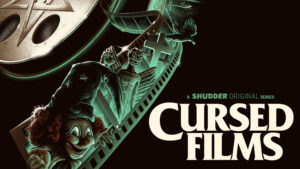
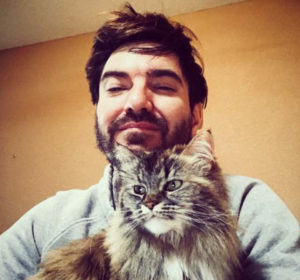
Showrunner Jay Cheel was supposed to premiere his five-part documentary series Cursed Films (reviewed on this site) at the 2020 SXSW Film Festival, but COVID-19 got in the way. So instead of interviewing him there, I had to chat with him on the phone, instead, the two of us holed up in our respective isolation spots. A vibrant fellow, he makes a fine conversationalist, taking me through his process with great detail. Premiering today on Shudder, the series explores the ins and outs of the ostensibly cursed productions of, in order, The Exorcist, Poltergeist, The Omen, The Crow and Twilight Zone: The Movie. I have only seen the first three episodes; at the time of the interview, I had only seen episodes 2 and 3. Here is a condensed digest of our conversation, edited for length and clarity.
Christopher Llewellyn Reed: Jay, I was so sorry to not be able to see your two episodes at SXSW, though I have watched them remotely.
Jay Cheel: Yeah. We’re bummed it didn’t happen either, but I think we’re learning now that it was with good reason. I feel worse for the filmmakers who didn’t get to go to the festival with their features who might have been looking for distribution or sales. I mean, we’re lucky enough to be premiering on Shudder on April 2, so it was kind of a bonus screening for us, but yeah, it would have been fun.
CLR: What is Shudder? I hadn’t really heard of it until your series came my way.
JC: Shudder is a horror-focused streaming service. It’s owned by the AMC Network, and it’s basically like Netflix, but with a genre perspective, more specifically horror films. So anyone who’s into horror films, it’s right up your alley.
CLR: So was this series, Cursed Films, originally your idea that you then pitched to Shudder, or did they approach you?
JC: They approached me, and it was a perfect fit for me because I’m a big horror film fan, and the films that we cover in the series are films that I grew up watching, especially Poltergeist and The Exorcist, so it was a great project for me. I just felt like there was something to the material where we could dig beyond the internet version of these stories, this idea of these campfire stories surrounding these cursed legends. I wanted to get past that a little bit and investigate why we’re so fascinated by these legends, and why these legends are connected specifically to horror films, and how horror kind of opens us up to supernatural thinking.
CLR: Did you have any say in the picking of the movies, or did they just present you these five? And how did you, or they, decide the broadcast order?
JC: I did not. Well, I suggested … Poltergeist was supposed to be the first one, but I think that changed at some point. So they were kind of shot with a certain order in mind, but it’s less about which episode is first and more about which ones are front-loading the season and which ones are back-loading. Because there is a bit of an arc to the series, and I think once people watch it on the service, they’ll recognize that. We always knew we were going to end with Twilight Zone: The Movie, and anyone who’s familiar with that story might understand why. It’s a very tragic episode, and one of our heavier episodes. So that’s kind of where the trajectory of the series as a whole was going.
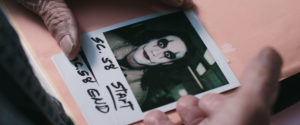
CLR: Sure. I mean, what I know about both The Crow and Twilight Zone: The Movie is that of the five, those are the two where people actually died on set. And so that, in some sense, is a curse that you could claim is related to things happening during the shooting of the movie, whereas for the other films, it’s perhaps a little more amorphous.
JC: Yeah. In both of those films, as you mentioned, they happened on set and cameras were rolling for both of those tragedies, and the film footage connected to The Crow was ultimately destroyed. The film footage for Twilight Zone: The Movie, however, became part of a trial. So I think it also speaks to the idea of these supposed cursed events being captured on film, and how that changes how we perceive the cursed events when you can actually witness what happened, and there’s sort of a reality check there. So there’s a little bit of an arc there, in terms of how those specific curses slot in with the other more fun campfire-story versions surrounding The Omen and Poltergeist, even though there are tragedies connected to those films, as well.
CLR: One of the things that really struck me watching the episodes I saw is your talking-head interviews. They’re all, for the most part, perfectly centered in the screen, which is different from the usual convention of rule of thirds. How did you arrive at that framing?
JC: I’m just a fan of that look for talking-head interviews. I think it creates a uniformity amongst all of the speakers, and it’s not an original concept in any way. Someone like Errol Morris is thought to have almost invented the idea of someone looking directly down the barrel of the lens and speaking directly to the audience. And while we didn’t implement the technical sort of gadgets that he uses to create that effect, I just simply asked my subjects to speak into the lens, and then I talked to them from behind the camera, and it just usually kind of naturally flowed. So I’m a big fan of just giving that sense that the subject is talking directly to the viewer.
CLR: And it is, perhaps appropriate to the series, a little more unsettling than looking off to one side. So I think it suits your series, for what it’s worth.
JC: Yeah. And when the people connected to these cursed stories are speaking honestly and openly about how the legends have affected them and what they witnessed during these tragedies, I think they’re talking in a way directly to the people who have shared those legends amongst themselves and their friends, and I think there’s an intimacy there that is important for this particular series. And I also feel like sometimes when the subject is talking to the left or right of the lens, to the filmmaker, it can feel a little bit news magazine-ish, and I didn’t want to suggest myself being behind the camera. I wanted that engagement to be between the audience and the subject.
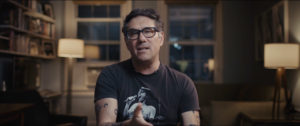
CLR: Although I believe we do hear your voice a few times asking questions, so you didn’t entirely leave yourself out.
JC: No. There are some occasions where I think there was a bit of a requirement to hear me from behind the camera, but as little as possible. I like to remain completely anonymous, if possible.
CLR: Sure. So in your episode on The Omen, you bring in some quite outlandish characters, at least from my perspective, among them a witch and a black magician, which takes you a little bit away from the actual movie. How did you find them and decide to include them in the series?
JC: Well, we found them on the internet. There’s a whole world full of black magicians and witches that you can access quite easily, especially through YouTube. Eric Koetting, who’s our black magician, actually does a ritual and curses a film in the series. He hosts his own YouTube show where he instructs people on how to do these rituals, and that was how we found him. And although I think in the episode, for some, they do come across as outlandish, and Eric certainly has a big personality, and Nate, who’s also a black magician, would refer to himself as a Satanist, they both have quite the presence on screen. But I will say that all of those people were some of the nicest, most polite and curious people that I met during the making of this series. So although I don’t necessarily believe in a lot of the stuff that they believe in, it was a lot of fun talking to them and hanging out with them.
CLR: I bet! And there was that one scene, which I thought was a particularly interesting bit of cinematic juxtaposition, where your black magician is filming himself with a Blackmagic camera. Total coincidence, perhaps, or maybe he chose that knowing that he was a black magician. But they’re good cameras, so why not?
JC: (laughs) Yeah. I mean, if you’re a black magician and you’re looking for a new camera, I guess that’s the way to go.
CLR: So, how did you find your academics, then? You’ve got psychology professors, professors of religious studies, and they’re all really interesting, including Hector Avalos and others. And I particularly liked Michael Shermer.
JC: Well, some of them, like Michael Shermer, I was aware of before going into the series. I had heard him on a number of podcasts, and so he was someone that from the very beginning I was hoping to be able to reach out to and get involved in the show, and he was kind enough to take part. And everyone else, it was just through general research, reading their books, and just reading articles online about horror films and religion, and how horror films encourage supernatural thinking even amongst the most skeptical of thinkers. I had done a project previous to this one, a short documentary called Twisted, which dips into this sort of urban-legend storytelling about a drive-in theater local to me that screened the movie Twister when it came out. The story is that a tornado actually hit the drive-in and tore the screen down while the movie Twister was playing. And even further to that, it was during the scene in Twister when a drive-in theater was hit by a twister.
So, it’s a crazy urban legend, and I was kind of, in that short documentary, doing some of this early research, as well, just in terms of mythologies and folklore and urban legends, and how unreliable our memories are, and how as storytellers we embellish over time to create more interesting stories. So, this is an area that I kind of explored a little bit previous to Cursed Films, and this project just gave me the opportunity to dig even further into that.
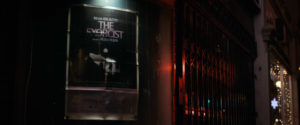
CLR: Was there anyone whom you approached who decided not to be in the film, or people that you just couldn’t get hold of that you would have liked to see in the series?
JC: Well, I would have loved to talk to John Landis, but I think it’s understandable that I was not able to get hold of him. I made it as far as his agent’s receptionist, and they suggested I write a letter to Landis. But I never really expected that he would take part in this, because he doesn’t really talk about the Twilight Zone event. There were some people involved with Poltergeist that I had hoped to talk to, but the challenge with this show is that though we’re approaching this material from, I think, hopefully a unique and different perspective, I think a lot of the people involved with these stories have talked about this stuff so many times in the past, and from the same sort of limited, sensational perspective, that it was tough to convince some people to take part.
Even some of the folks that are in the series took some convincing. Craig Reardon, who’s in the Poltergeist episode, and was a special makeup-effects artist who worked on that film, took a lot of convincing to get him to appear on camera, mainly because he took part in the making of an E! True Hollywood Story episode about the Poltergeist curse, and felt that it did a complete disservice to the memories of Dominique Dunne and Heather O’Rourke, and that it just kind of sensationalized the entire event. And he thought that this was going to be another sensational retelling of how some skeletons he used on the set of the film cursed the project and ultimately led to these young actresses dying. So it took some convincing. He was close with Heather, because he worked on the film, and to see how that was kind of twisted and shaped in the tabloid media, that kind of really pissed him off, to be honest. So he was really coming in guarded.
CLR: That’s so fascinating to hear, because it’s not that the episode isn’t strong without him, but that ending interview with him really elevates the episode beyond what it already was. It’s not just that he says, “These skeletons had nothing to do with the curse,” it’s that he dispels the whole notion that there’s something weird about using real skeletons on sets in the first place that I found fascinating and had never considered. And so that little tidbit of information really raises the episode to a whole other level. I’m so glad that you were able to get him.
JC: Well, I’m happy to hear that, because it’s a good example of what I love about the series, the idea of bringing someone in to speak to the curse of Poltergeist, but then getting a little bit of history about how horror films have been made, since he cites Frankenstein as an early example of horror films that used real skeletons on set. And once you hear it coming from a visual-effects artist or a special makeup-effects artist, you kind of understand that history. And for horror fans, this is the kind of stuff that I think is a lot of fun to hear, and I think it’s rare to get it directly from a source like that.
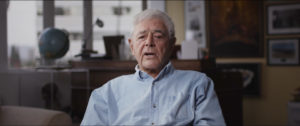
Even though we didn’t get some of the people that we were hoping to get that were directly related to the film, in terms of starring in these productions, we did talk to Linda Blair, from The Exorcist, and Richard Donner, who directed The Omen. It was really interesting speaking to some of the makeup-effects artists who were directly involved with the making of these films, and had some of the most emotional responses to what actually happened during the making of these films, and how the curse story has actually affected them over time. So it was a lot of fun and very interesting, and at times, very emotional speaking to some of these people.
CLR: Well, I found the episodes that I watched both entertaining and informative, and I want to thank you for making the series and for talking to me.
JC: Thank you, Chris!
[Cursed Films debuts on Shudder on April 2 with Episode 1, on The Exorcist]

